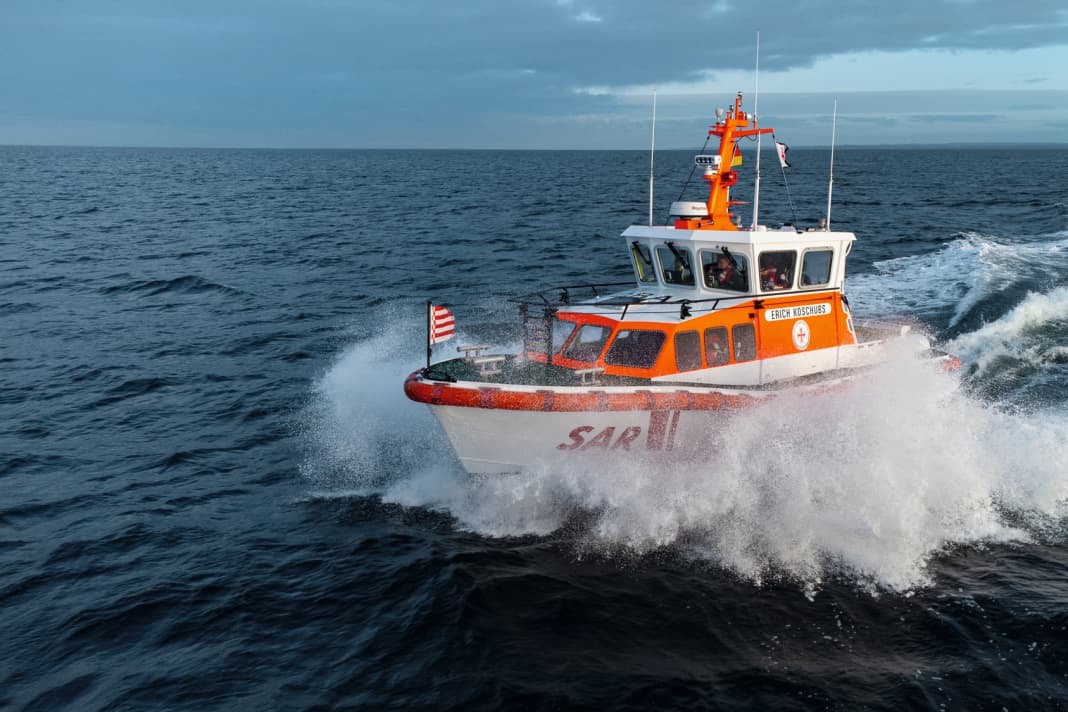





Sea rescue boat "Erich Koschubs"
When people get into distress at sea, the cause is often bad weather and human or technical error. However, capsizing, water ingress or engine damage are not always the reason why sea rescuers are called out. They also come when people fall ill or injure themselves on the high seas. When a crew member of the ferry "Finnfellow" collapsed unconscious in the engine room on 19 February 2022, a seamless rescue chain was set in motion that ultimately saved the man's life.
The sea rescuers at the Travemünde station are just returning from a training cruise on their rescue boat "Erich Koschubs" when they receive a call: a crew member on a ferry 20 nautical miles from Travemünde en route to Malmö has apparently had a heart attack. Now every second counts. While an emergency paramedic from the rescue control centre gives instructions for resuscitation over the phone, the "Erich Koschubs" is at full speed on its way to the ferry. Foreman Patrick Morgenroth has the Travemünde traffic centre clear the way, other ships have to wait. A ferry that suddenly turns in the middle of a narrow fairway can become a huge problem. At the same time, the emergency doctor and paramedics are brought to the rescue cruiser "Felix Sand" in Grömitz and the control centre requests helicopter support. The vehicles approach each other at top speed in the area that requires piloting and arrive at the same time. For the "Felix Sand", the "Finnfellow's" wall rail is a major obstacle. After a brief consultation, the leaders of the rescue units decide that the rescue boat, rather than the cruiser, should go alongside and allow the sea rescuers and medics to pass.
The 10.1 metre sea rescue boat approaches the 190 metre long ferry. The huge lettering "Finnlines" passes by on the side. In the second "i", foreman Patrick Morgenroth recognises the open pilot door and the rope ladder. The small boat bounces up and down in the swell. The engine is running at full speed. Morgenroth is highly focussed. The manoeuvre has to work, and quickly. Somewhere down there in the belly of the ship, a few sailors are fighting for their colleague's life. Finally, he manages to go alongside in heavy seas at the height of the pilot ladder. Dr Jörg Sandmann, volunteer emergency doctor at the Travemünde station, and his colleagues bravely grab the ladder and go on board. They take over the resuscitation and manage to stabilise the patient to such an extent that he can be transported. The next challenge: the man has to be brought up seven decks of the ship to the winch deck while being ventilated. With the stretcher over his head, he is carried up the narrow stairways to the upper deck. In the meantime, the winch manoeuvre has already been prepared to rescue the patient with the rescue helicopter that has now arrived.
Sea rescue boat "Gillis Gullbransson"
Transport by helicopter is not always possible. In such cases, injured and sick people sometimes have to be lowered several metres down the side of the ship. This was the case on 19 August 2009, when the DGzRS station in Brunsbüttel received an emergency call about a seriously injured seaman on board the container ship "Husky Racer". The rescue boat "Gillis Gullbransson" has been stationed in front of the canal locks in Brunsbüttel since 1999. Its area of operation is the busy Outer Elbe area with the approaches to the Port of Hamburg and the Kiel Canal. The volunteer sea rescuers first transfer the paramedic and emergency doctor to the container ship and then take the patient on board using the basket stretcher and bring him ashore. The crew from Brunsbüttel has some experience in rescuing people from container ships. A year earlier, they rescued a seriously ill young Indonesian woman, a crew member of a bulk carrier. 15 minutes after the call from the rescue coordination centre, the crew of the "Gillis Gullbransson" is on its way with two sea rescuers and two rescue assistants. They have to climb 20 metres of pilot ladder to reach the patient and rescue her the same way. Thanks to years of experience and regular training, the well-rehearsed team succeeds in this courageous endeavour. They routinely secure the patient, treat her on board and hand her over to the rescue team on land.
Here you can find the other two parts of the sea rescue report:
Further information: www.seenotretter.de

